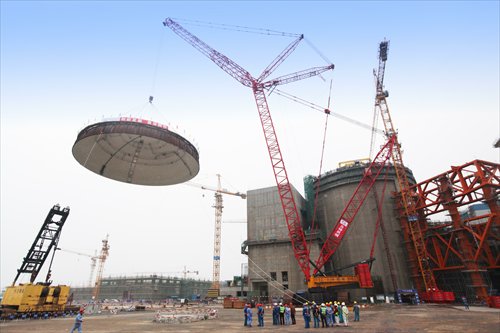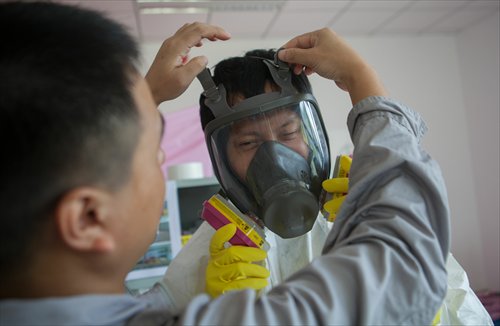China resumes nuclear power plant construction after a four-year freeze
As pollution deteriorates and targets were announced to expand the number of zero-emission power sources, China recently ended its pause for approvals of nuclear power plants put into place after the 2011 nuclear accident in Japan. This year, as many as eight nuclear power plants may be launched in China. Some experts are warning that this is going too fast with controversial technology.

Workers hoist a vault to construct a generator at the Hongsha Nuclear Power Station on December 26, 2012, in Fangchenggang, Guangxi Zhuang Autonomous Region. Photo: CFP

A worker helps a visitor to suit up in radiation protective clothing at the Dayawan Nuclear Power Plant in Shenzhen on its opening day on August 7, 2014. Photo: CFP
In the biggest IPO in China in almost five years, China National Nuclear Power Corp, headquartered in Beijing, raised 13.19 billion yuan ($2.12 billion) last Wednesday, according to the company's statement on the Shanghai Stock Exchange.
The stock price of the first nuclear company ever listed in China's mainland jumped 44 percent, the maximum allowed for new listings, the first day of its debut, to close at 4.88 yuan from 3.39 yuan.
Investors are not just betting on China's booming stock market, but also on China's latest effort to expand its nuclear power industry both home and abroad, driven by China's pledge to cut its carbon emissions and upgrade its foreign trade.
But discussions have already begun to surface over whether China's latest nuclear renaissance is going too fast, and if China is capable of keeping its 27 nuclear power plants currently under construction - over a third of the nuclear power plants being built worldwide - under control, let alone exporting its nuclear technology overseas.
Back in full swing
The 2011 Fukushima Daiichi nuclear disaster cast doubts over nuclear power worldwide. Following the incident, Germany and Switzerland, where nuclear power contributes 16 and 38 percent of national power output, decided to completely phase out nuclear power by 2022 and 2034.
In France, the world's most nuclear-reliant country where nuclear power makes up 76.9 percent of its energy production, discussions have been going on over whether it should reduce nuclear power's dominant share.
China, where the share of nuclear power was less than 2 percent, also joined the international trend, pausing its approvals for new nuclear plants in 2011.
But as pollution worsens and as targets were announced to expand the share of zero-emission sources, China seems to have no other choice but to turn to nuclear power, which also boasts higher efficiency than other new energy resources, low running costs and less disturbance of habitat compared with hydropower stations.
In 2012, then premier Wen Jiabao made it clear that it was on the central government's agenda to resume China's nuclear programs.
In a document on energy strategy issued last June, China's State Council said construction of new nuclear power plants in coastal areas in East China will start at a proper time, and the feasibility of building plants in inland ares will be studied.
Few actions were taken until this year. In February, the State Council approved the construction of two units of the Hongyanhe Nuclear Power Plant in Northeast China's Liaoning Province, making it the first project that was approved after 2012. This was followed by the construction of unit five of the Fuqing Nuclear Power Plant in Fujian Province, which started in May.
More projects are likely to follow. In an energy forum held this May, Liu Baohua, who's in charge of nuclear power at the National Energy Administration of China, said that as many as eight nuclear power reactors could be launched this year, China Nuclear Industry News reported. Liu also said that it is within China's capacity to build six to eight more nuclear reactors each year.
By 2020, China expects that installed nuclear power capacity will reach 58 gigawatts, and those under construction will reach 30 gigawatts. This is nearly three times the current capacity, which is 20.29 gigawatts, or 1.5 percent of China's total electricity capacity.
According to the International Atomic Energy Agency, nuclear power generated by China's 23 nuclear reactors contributed to just 2.4 percent of China's total electricity production in 2014.
"China resumed its new nuclear energy activities rather soon this time, after just a four-year pause. This is mainly prompted by the advance of nuclear technology and safety standards, and more importantly, voices from within China to change its energy structure toward a cleaner one," Lin Boqiang, director of the China Center for Energy Economics Research at Xiamen University, told the Global Times.
Bold experimenter
Not only is China fast in its pace to build more nuclear reactors, it's also bold in using the most advanced nuclear technologies, some of which have never been used commercially before. This courted doubts over whether these technologies are reliable enough, since there are few precedents to draw experience from.
Since 2004, China has been approving projects using advanced nuclear power reactors, including US-based Westinghouse's AP1000 and France-based Areva's EPR (Evolutionary Power Reactor), many of which are now under construction. Dubbed generation III reactors, they are designed to withstand the crisis that damaged the Japanese nuclear plant.
Construction of these projects has not been smooth. Sanmen Nuclear Power Station in Zhejiang Province was expected to be the first nuclear power plant in the world that uses AP1000 technology. The first of the two reactors was scheduled to finish construction and start operation in November 2013, but construction is now over 18 months behind schedule. The plant won't start operation until 2016 at the earliest, an official from China's State Nuclear Power Technology, the company building the power plant, said in January.
The company has struggled to keep its schedule because of constant changes in design and new problems that emerged during tests, previous reports said.
In a statement by the economic planner of Zhejiang Province in 2013, its energy department said the delay has slowed down the province's nuclear development and affected the power supply plan in Zhejiang. It has also undermined China's overall plan to make AP1000 its major technology in new nuclear plants.
In Guangdong Province, the Taishan nuclear plant, scheduled to finish this year, is likely to be the first EPR power plant in the world to finish construction and start operation.
Two EPR plant projects launched before Taishan are the Olkiluoto 3 in Finland and Flamanville 3 in France. Each encountered technical delays and weaknesses and won't finish construction until 2017. France's nuclear officials have more than once voiced concerns over the safety of Taishan, which could face the same problems as the Finish and French projects.
Apart from imported technology, China is also experimenting with its own nuclear technology, Hualong One. The first of two Hualong One units planned for the Fuqing plant in Fujian Province officially started construction in May as a demonstration project.
"This is China's first indigenous nuclear power design, with China's own intellectual property rights. It will play an important role in China's export of nuclear technology," Lin said.
Inland plants
So far, all of the nuclear power plants in operation and under construction in China are located along the coast. Coastal power plants are favored because sea water is a natural and free source for power plant cooling, and building nuclear power plants by the sea reduces its potential risks.
But discussions of inland nuclear power plants have been going on for years. Plans for the construction of three inland plants in Hunan, Hubei and Jiangxi provinces were suspended after the Fukushima accident and have not yet been re-approved. But observers say inland nuclear power plants are very likely to be approved in the coming 13th five-year plan.
Wang Yinan, a researcher with the Development Research Center of the State Council, said the risk is too high to build nuclear power plants in China's inland, citing the dense population, the uncertainty of China's nuclear power plants, China's inability to deal with radioactive waste and the lack of stable water resources in inland areas to act as coolants.
She said hydroelectricity and other new energy means should be developed in inland areas. "Nuclear shouldn't play an important role in China's energy structure," she said.
Don't worry
The lack of precedents of these projects and China's push to launch more have had some experts call this experiment "the Great Leap Forward of nuclear power," including He Zuoxiu, a Chinese physicist and member of Chinese Academy of Sciences.
"The rapid speed of China's nuclear expansion, and the direction it is expanding - to the most populous inland areas - is unprecedented…Besides, China's nuclear industry has a tendency to exaggerate its achievements to the central government, so as to gain more funding," He told the Global Times.
He also warns of a nuclear accident when the total number of nuclear power plants reaches 50 - the total number of nuclear plants built and under construction in China.
"According to past experiences, the likelihood of a disaster rises sharply after a country runs over 50 nuclear power plants, as is the case in the US and Japan," he said.
In an interview with China Economic Weekly, Zhang Huazhu, chairman of China Nuclear Energy Association, said, "I don't think it's proper to use Great Leap Forward to describe the current nuclear development. China is building [its nuclear power plants] in a sturdy way, and safety and stability will be ensured in future operation."
Newspaper headline: Nuke industry sprints ahead